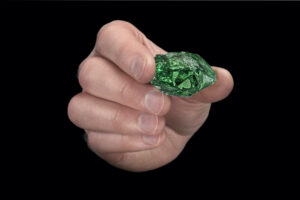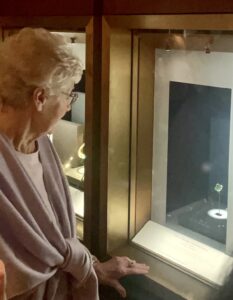By Jennifer Heebner, Editor in Chief
When the Lion of Merelani Tsavorite was uncovered in Merelani, northern Tanzania, in 2017, Bruce Bridges knew something remarkable had been found, but just how exceptional wasn’t immediately clear.
“I wasn’t there that day,” says the owner of Bridges Tsavorite, who mines in southern Kenya. “But I heard that something special was coming out of the ground.”
A few weeks later, Bridges, son of Campbell Bridges, discoverer of Tsavorite in 1967, who was murdered by assassins in August 2009, saw the treasure for himself: a massive 283-plus ct. piece of rough that was a remarkably clean crystal with astounding green hues.
Rockhounds know the rarity of the find. Tsavorites are rarely found in sizes exceeding 10 carats, making this one a memorable discovery, to say the least.

Once this majestic gem was uncovered and Bridges acquired the rough, he and industry peers and friends embarked on a unique journey. They would not only bring the faceted Lion to life as a 116.76 ct. square cushion cut—another feat in the Tsavorite world—but also see it land in the most prestigious permanent U.S. home of all, the National Gem Collection within the Janet Annenberg Hooker Hall of Geology, Gems, and Minerals at the Smithsonian Natural History Museum in Washington, D.C.
The Lion of Merelani debuted at the museum last Thursday, April 20, to hundreds of guests, both distinguished and John Q. Public. Many generations of both will enjoy the treasure long after those who secured its station in the capital are gone.
“It was like watching your baby go to its new home,” says Shelly Sergent, Curator of the Somewhere in the Rainbow Collection (SITR), which had a hand in seeing the Lion matched with its ideal suitor.
“So many have dedicated so much to Tsavorite and this gem that the unveiling was a pinnacle moment for us,” she explains. “We wanted to honor the Bridges family and legacy, for everything Campbell did—and his family still does—in the name of gemology. We also wanted to recognize Jeff Post’s 40 years of service to the museum (Jeff retires in May). The Lion is a gift to the entire gem industry, and the unveiling ceremony was a moment of magic.”
Rough Makes the Rounds
Once the Lion was found, it didn’t take long for Bridges to mastermind a comprehensive strategy for it.
“He called me in 2017 when he got back from the Hong Kong show, saying, ‘You will not believe this massive, phenomenal piece of rough Tsavorite that came into my hands,’” Sergent recalls. “And in typical Bruce fashion, after purchasing the gem, he quickly developed detailed plans for it to be cut. He wanted to document the whole process from rough to finished gem, so we talked about possibly collaborating on it.”
As conversations about possibilities snowballed, Sergent approached SITR owners; they didn’t ordinarily add rough to their collection, but wouldn’t it be amazing to travel this journey with Bridges, documenting the process of rough to cut gem and finding it a home? If it were sold, it seemed it would ultimately land in Asia.

“Many important stones tend to sell to collectors in Asia, and then nobody sees them again,” says Bridges. “We wanted it to be cut in the U.S. and stay in the U.S., so we explored how that might happen.”
Fortunately for Sergent and Bridges, SITR owners were intrigued by the idea of involvement. So enthused were they, that they instructed Sergent to work with Bridges to ensure it was seen in Tucson in 2018, where the gem world meets.
Master Meets Gem
At the show, with rough in hand, Sergent introduced Bridges to industry legend Victor Tuzlukov, a Russian-born, world-renowned grand master cutter of important gems. Tuzlukov, whose portfolio and skillset were exactly what the Lion needed, was a frontrunner in the process. After interviewing many cutters from around the world, it was decided at the show that Tuzlukov would have the job.

“Though my company has cut more Tsavorite than anyone, cutting one of this size was out of our area of expertise,” says Bridges. “When you cut gems of this size, the equipment, the dops, everything, is completely different.”
In April 2018, Tuzlukov moved stateside from his residence in Thailand to be near Bridges’ office, where a specialized cutting station identical to Tuzlukov’s own was set up. After cutting two test stones—a 31.57 ct. square cushion-cut Tsavorite and a 58.50 ct. cushion-cut Tsavorite—Tuzlukov tackled the Lion. It took about a month to complete, but with many months of prior planning.
“Bruce filmed and shot photos every day, and there was a photo of Campbell in the Kenya treehouse over Tuzlukov’s cutting station,” says Sergent.
The Gemological Institute of America (GIA) even sent a film crew to interview Bridges and Tuzlukov, who went into detail on his laser-mapped 3D model of the rough. Some of that documentation and story landed in the spring 2019 issue of Gems & Gemology.
Tuzlukov told GIA that the “material was amazing,” and that it was not only a pleasure but an “honor” to cut the gem.
From the 283 ct. rough, a 116.76 ct. square cushion cut took shape. This gem was bigger than any other Tsavorite in the museum’s collection, dwarfing its 15.93 ct. Tsavorite. And because high pressure and temperature fragments Tsavorite during formation, pockets found often yield rough akin to long thin shards of broken glass, making square shapes rare to cut.
“It’s easier to cut long shapes like marquise, ovals, and pears,” says Bridges. “It’s seldom that we have a blocky, equilateral piece of rough that lends itself to being cut in a square shape because of the potential massive weight loss. Gemstones are often cut for yield, so that’s why you see few rounds or square shapes above 2 carats. The Lion was cut for beauty and light performance. We weren’t cutting for weight retention as is traditionally done with large stones.”
The Lion Finds a Home
When the cut gem was complete, its permanent home had not yet been decided. But in 2019, Smithsonian staffers, including Jeffrey Post, longtime Mineralogist and Curator-in-Charge of Gems and Minerals, finally got to see it in person. This was a directional point for the gem.
Not only did the Bridges family already have a long relationship with the Smithsonian, but Post’s visceral reaction of joy upon seeing the Lion in Tucson cemented thoughts from SITR and Bridges to move forward with a donation.

“The pathway became clear that the Lion should make the Smithsonian Gem Hall its final dominion,” says Sergent. “This donation speaks strongly to SITR’s devotion to colored gemstone education.”
Just ahead of the Lion’s unveiling at the museum last week, a sleep-deprived-from-excitement Bridges and his entire family, including mom Judith, traveled to D.C. The Lion landed in its own showcase in a room with the Hope Diamond—not too shabby.
Speeches were made by Sergent, Post, and Bridges, followed by the unveiling. Judith and the Bridges’ three children, Bryce, Ava, and Brock, along with the Smithsonian Director Kirk Johnson, pulled back the drape.
School children on a field trip rushed the case, leaving little fingerprints that pointed and marveled at the majesty of the Lion, straining to see the fuss everyone had made about this kryptonite green gem in a glass box. Whether they understood it or not, history was made that day.

According to Bridges, the Lion is the largest and first 100-plus ct. square cushion-cut Tsavorite to ever be cut, the first 100-plus ct. Tsavorite to ever be cut in North America, and the largest precision-cut Tsavorite in the world.
The day was an emotion-packed one all around, and one that Bridges and the SITR donors won’t ever forget.
“It was the culmination of a 55-year-plus relationship with my family and the Smithsonian, honoring my father’s legacy and this treasure, one of the most important Tsavorites ever found,” he says. “To have my entire family there was a moment I’ll cherish forever.”
And that name, the Lion of Merelani, where did it originate? The Lion is what many in Kenya called Campbell, for his bravery and strength—and maybe a little bit because of his beard. “He always had one, and it always seemed like a lion’s mane,” muses Bridges. “He was the king of Tsavorite and the lion is the king of the jungle, so the two go hand in hand.”
This is proprietary content for AGTA and may not be reproduced.
